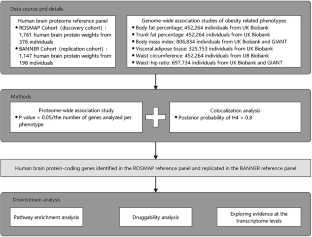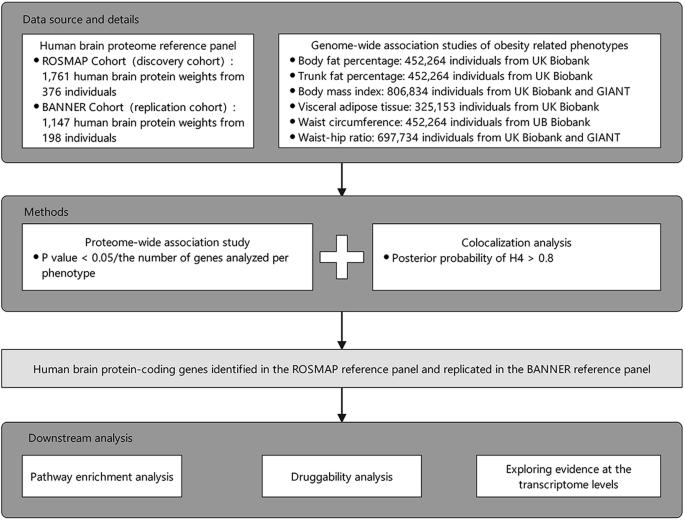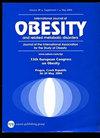Human brain proteome-wide association study provides insights into the genetic components of protein abundance in obesity
IF 4.2
2区 医学
Q1 ENDOCRINOLOGY & METABOLISM
引用次数: 0
Abstract
Genome-wide association studies have identified multiple genetic variants associated with obesity. However, most obesity-associated loci were waiting to be translated into new biological insights. Given the critical role of brain in obesity development, we sought to explore whether obesity-associated genetic variants could be mapped to brain protein abundances. We performed proteome-wide association studies (PWAS) and colocalization analyses to identify genes whose cis-regulated brain protein abundances were associated with obesity-related traits, including body fat percentage, trunk fat percentage, body mass index, visceral adipose tissue, waist circumference, and waist-to-hip ratio. We then assessed the druggability of the identified genes and conducted pathway enrichment analysis to explore their functional relevance. Finally, we evaluated the effects of the significant PWAS genes at the brain transcriptional level. By integrating human brain proteomes from discovery (ROSMAP, N = 376) and validation datasets (BANNER, N = 198) with genome-wide summary statistics of obesity-related phenotypes (N ranged from 325,153 to 806,834), we identified 51 genes whose cis-regulated brain protein abundance was associated with obesity. These 51 genes were enriched in 11 metabolic processes, e.g., small molecule metabolic process and metabolic pathways. Fourteen of the 51 genes had high drug repurposing value. Ten of the 51 genes were also associated with obesity at the transcriptome level, suggesting that genetic variants likely confer risk of obesity by regulating mRNA expression and protein abundance of these genes. Our study provides new insights into the genetic component of human brain protein abundance in obesity. The identified proteins represent promising therapeutic targets for future drug development.


人脑全蛋白质组关联研究深入揭示了肥胖症蛋白质丰度的遗传因素。
背景:全基因组关联研究发现了多个与肥胖相关的基因变异。然而,大多数肥胖相关基因位点仍有待转化为新的生物学见解。鉴于大脑在肥胖发展中的关键作用,我们试图探索肥胖相关基因变异是否可以映射到大脑蛋白质丰度:我们进行了全蛋白质组关联研究(PWAS)和共定位分析,以确定顺式调控的脑蛋白丰度与肥胖相关特征(包括体脂率、躯干脂肪率、体重指数、内脏脂肪组织、腰围和腰臀比)相关的基因。然后,我们评估了鉴定出的基因的可药性,并进行了通路富集分析,以探索其功能相关性。最后,我们在脑转录水平上评估了重要的PWAS基因的影响:通过整合发现数据集(ROSMAP,N = 376)和验证数据集(BANNER,N = 198)中的人类大脑蛋白质组与肥胖相关表型的全基因组汇总统计(N 从 325,153 到 806,834 不等),我们发现了 51 个顺式调控大脑蛋白质丰度与肥胖相关的基因。这 51 个基因富集在 11 个代谢过程中,如小分子代谢过程和代谢途径。这51个基因中有14个具有很高的药物再利用价值。51 个基因中的 10 个基因在转录组水平上也与肥胖有关,这表明基因变异可能通过调节这些基因的 mRNA 表达和蛋白质丰度而导致肥胖风险:我们的研究为了解肥胖症中人脑蛋白质丰度的遗传因素提供了新的视角。结论:我们的研究为了解肥胖症患者大脑蛋白质丰度的遗传因素提供了新的视角,所发现的蛋白质是未来药物开发的治疗靶点。
本文章由计算机程序翻译,如有差异,请以英文原文为准。
求助全文
约1分钟内获得全文
求助全文
来源期刊

International Journal of Obesity
医学-内分泌学与代谢
CiteScore
10.00
自引率
2.00%
发文量
221
审稿时长
3 months
期刊介绍:
The International Journal of Obesity is a multi-disciplinary forum for research describing basic, clinical and applied studies in biochemistry, physiology, genetics and nutrition, molecular, metabolic, psychological and epidemiological aspects of obesity and related disorders.
We publish a range of content types including original research articles, technical reports, reviews, correspondence and brief communications that elaborate on significant advances in the field and cover topical issues.
 求助内容:
求助内容: 应助结果提醒方式:
应助结果提醒方式:


